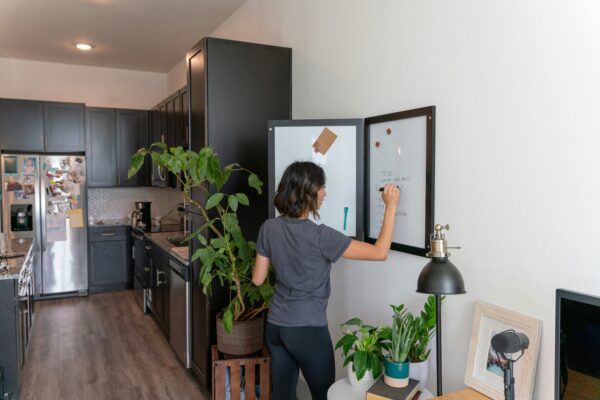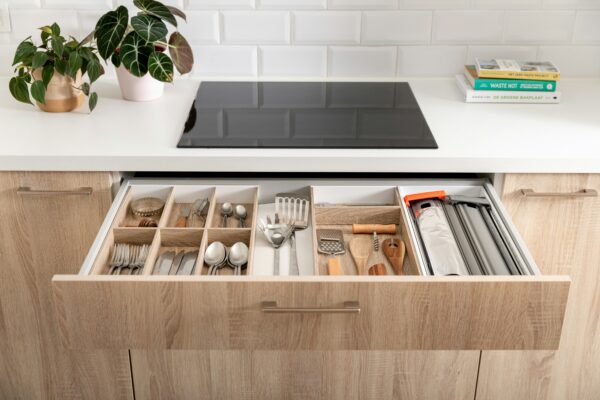A cluttered kitchen is the bane of efficiency and a barrier to culinary creativity. In a world where more is frequently mistaken for better, the minimalist kitchen stands as an oasis of order and simplicity—a space where every item serves a true purpose. It’s a philosophy that not only harmonises with a modern, streamlined aesthetic but also underscores the practical orientation that kitchens are uniquely poised to embody.
But how do you pivot from a kitchen that’s bursting at the seams to one that’s sleek, functional, and still brimming with the potential to satisfy the desires of any home chef? The answer lies in decluttering and strategic streamlining.
This blog post is designed to walk you through the essential steps to achieve a minimalist kitchen that both reduces stress and increases enjoyment. Whether your motivation is rooted in an aesthetic preference, an admiration for functionality, or an environmental consciousness that calls for less waste, these strategies will help you reimagine your culinary space.
Setting the Stage for a Minimalist Kitchen
Before you roll up your sleeves and begin sifting through your kitchen drawers, it’s essential to establish what a minimalist kitchen means to you. Is it a sterile, all-white space with only the most basic tools, or is it a warm, welcoming area that celebrates simplicity through the sensible use of materials and colour?
Your vision will dictate the process, so start by envisioning what you want your kitchen to feel like. Here are some ways to scope out the vision:
Create a Moodboard
Gather images, colours, and textures that evoke the feeling and style you desire for your kitchen. Pin them on a board or create a digital collage that you can refer to during the transformation.
List Your Priorities
What activities are non-negotiables in your kitchen? Whether it’s preparing elaborate meals, hosting dinner parties, or simply enjoying a morning coffee in solitude, knowing your kitchen’s primary functions will guide you towards what to keep and what to cut.
Understand Your Needs
Minimalism should not come at the cost of functionality. Make a list of the types of food you typically prepare, the cookware that facilitates these tasks, and special tools that make your life easier. These will form the core of your minimalist kitchen.

The Art of Decluttering Your Kitchen
Clutter doesn’t just affect the aesthetic appeal of your space—it also acts as a cognitive distraction. Studies have shown that messy environments can lead to heightened anxiety and an inability to focus.
To begin your minimalist kitchen makeover, you’ll need to declutter. Here are four strategies to help you get started:
The Sentimental Clear-Out
Start with items that hold sentimental value. We’re often inclined to keep things we don’t need because they summon an emotion. Ask yourself, “Is the space this takes up worth the sentiment it carries?” You might find that keeping a photograph of your grandmother’s kitchen is more evocative than keeping her chipped old teapot.
The ‘When Did I Last Use This?’ Test
If you haven’t used an item in the past year, it’s likely you won’t miss it. There might be specialised tools you use once in a blue moon, but for the most part, kitchen appliances fall into regular rotation or they don’t.
The Multipurpose Philosophy
Streamline tools and gadgets that perform multiple functions. Cutting down on single-use items like an avocado slicer or a garlic press in favour of a versatile vegetable cutter or a simple masher can significantly reduce clutter.
The Duplicates Dilemma
How many spatulas does one kitchen need? Duplicate items, unless used very frequently, are often more indicative of disorganisation than preparedness. Keep only the best or most versatile of each item.
Streamlining Your Culinary Arsenal
Now that you’ve culled the unnecessary, it’s time to organise what’s left.
The One-In-One-Out Rule
Adopt a policy of getting rid of an old item whenever you acquire a new one. It keeps the volume of items in your kitchen at a manageable level and forces you to be selective about what enters your space.
The Spatial Awareness Principle
Place items where their use is most logical and convenient. If you cook a lot of Asian cuisine, your soy sauce and fish sauce should be within arm’s reach of the stovetop. Store baking items next to the oven. This not only saves time searching for things but also ensures that you notice when an area becomes too crowded.
The Container Strategy
Use clear, stackable containers for ingredients. Not only do they look neater, but they can also extend the life of your pantry staples. Furthermore, their uniform shape and size make stacking and storage more space-efficient.

Maintaining Your Minimalist Kitchen
Congratulations, you’ve streamlined and decluttered your kitchen! Now comes the crucial step of maintaining this serene space.
Regular Assessments
Every few months, perform a quick sweep to identify items that may have crept in unnoticed and don’t serve a purpose. Stay vigilant about new items and ensure they have a defined role or utility.
Mindful Shopping
With your finely tuned culinary arsenal, you now have clarity on what you truly need. Future purchases should be a result of thoughtful consideration rather than impulsive buys. Quality always trumps quantity.
Rethinking Gifts and Souvenirs
Communicate with friends and family about your kitchen’s needs, particularly around gift-giving occasions. Rather than accumulating token items, suggest experiences or consumables that won’t add to your physical load.
The Joy of a Minimalist Kitchen
A minimalist kitchen is more than just a design trend—it’s a reflection of intent and mindfulness in an often-overlooked space. It celebrates the things that matter, brings focus to the act of nourishing, and encapsulates the beauty of a purpose-filled life.
By clearing the clutter and streamlining your kitchen, you optimise the area for what it’s meant to do—be a stage for delicious meals, a centre for social interaction, and an anchor for daily rituals. It’s not about deprivation; it’s about elevating and clarifying the experiences that engage your senses and satisfy your soul.
Minimalist living extends beyond the kitchen to encompass every aspect of our lives, from our wardrobes to our workspaces. But the kitchen, with its sensory delights and emotional resonances, is a particularly compelling place to cultivate a sense of balance and restraint. Start there, and the rest of your home—and even your life—may just follow suit.
Check out the recent Rent. article we were featured in:
Life gets busy. Creating an organized pantry makes finding what you’re looking for quick and easy. It also helps you remain mindful of what you have in stock and what to add to the grocery list. Not only do you save time, but you also save money.
Rent.’s article, Pantry Organization Ideas to Streamline Kitchens and More explores tips and tricks to create an organized pantry that makes your life, and your recipes, that much easier.
Read the full article here: Pantry Organization Ideas to Streamline Kitchens and More | Rent.

